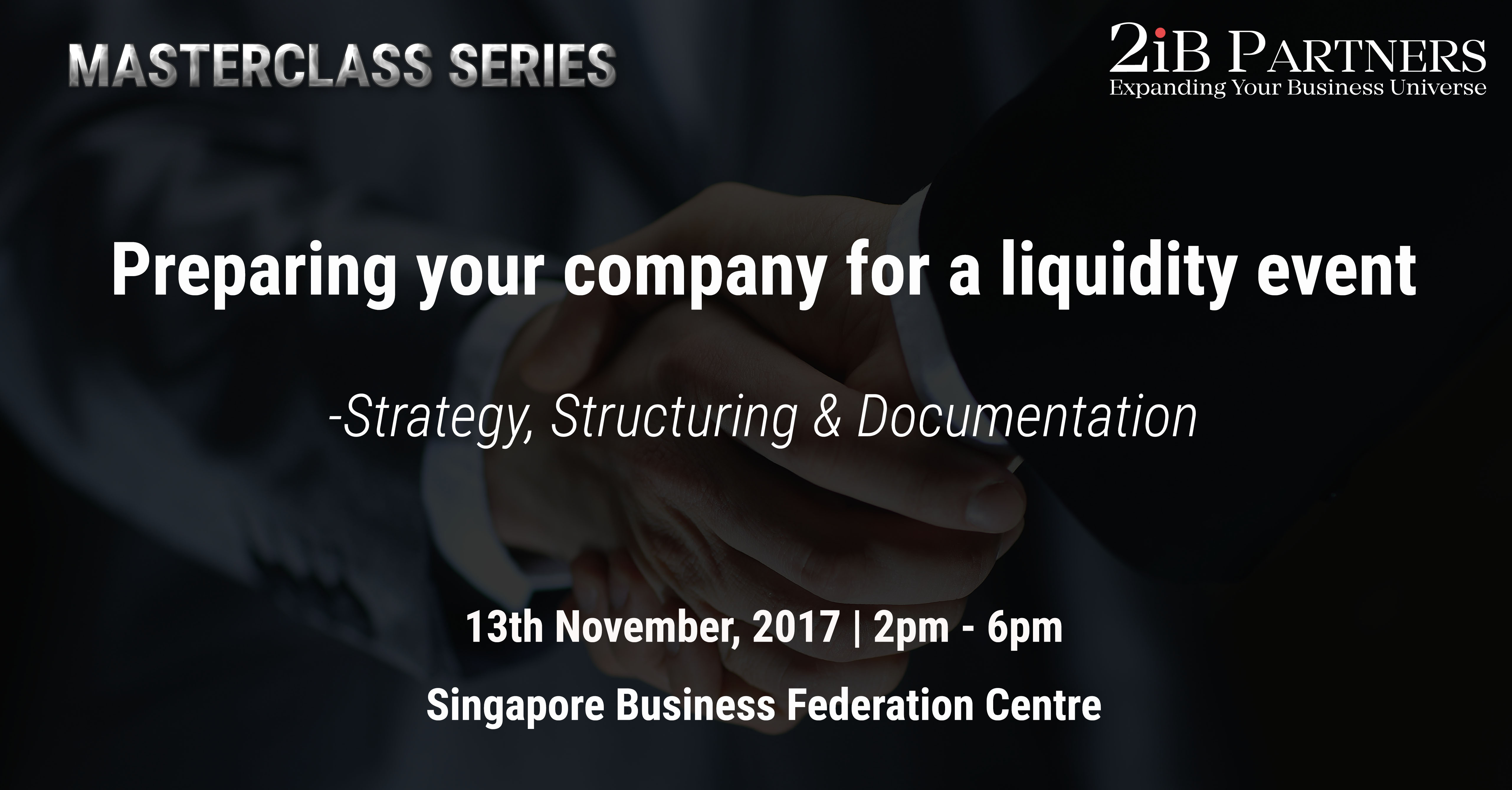Representations and warranties in contract containing the liquidity events that could make or break a deal
Sometimes overlooked as standard clauses, a target is willing to give any…

8 Legal Points to note during a Liquidity Event
Flashing back to Part 1, a liquidity event is an exit strategy for investors to convert their equity into cash and occurs when any of the following typical change of control events takes place:
- merger
- acquisition
- sale purchase – part or whole, shares or assets
- leveraged recapitalization – debt to finance purchase of equity
- ESOP
- IPO of a company
The occurrence of liquidation, dissolution or winding up of a company may also be included as a liquidity event.
Continuing on from Part 2: 8 Considerations before the liquidity event, which in summary talked about the below 8 considerations, we now move on to Part 3: 8 Legal Points to note during a liquidity event.
- Types of entities involved
- Cash receipts or pay-outs
- Escrow Consideration
- Type of Equity
- Value of Equity
- Local Laws
- Effects on Employment
- Tax matters
As if Part 2 were not exciting enough, here is where the real exciting part comes. Here are practical things to take note of DURING the event itself. You’ve flirted ideas with your buyer/investor and finally there is some understanding and mutual agreement after a courtship process.
However, here is where you will need to get really cautious and have a full understanding on what each part means and why it is done. The below is a far from exhaustive list but points out some essential points to note.
8 Legal Points to note
At the liquidity event itself, the following legal issues should be considered:
- Representations and warranties in contract containing the liquidity events that could make or break a deal
Sometimes overlooked as standard clauses, a target is willing to give any and all representations and warranties that an acquirer is looking for. But this could be quite dangerous as the sale and purchase agreement will invariably contain indemnity clauses and this will affect the deal. In a sale and purchase agreement, certain specific representations and warranties are covered within the substantive part of the agreement itself and many so-called standard clauses are covered as an annexure, schedule or attachment to the main agreement. The standard clauses are mostly the sum total of the experiences of professionals and standard templates that have evolved over time. Involvement of local lawyers is required. Misrepresentations could have serious legal repercussions.
- Covenants (to do or not to do something) and obligations. On pre-closing, closing and post-closing
As with all financial transactions, a buyer would seek to protect his money and delay payment until all conditions are satisfied and a seller would agree to do anything to receive the pay-out at the earliest. Incapacity to pay, failure to fulfil conditions, non-receipt of corporate and statutory approvals are some of the factors where the deals fall through. Post-sale, many negative covenants such as non-disclosure, non-compete, non-solicit and non-circumvention would continue to operate and can operate against the seller/target and affect the future operations of the target.
- Special rights that are covered in the agreement, such as options, transfer, approvals, put-call, drag-tag along, lock-ins/lock-ups, share-asset price ceilings
Liquidity events call for perusal and scrutiny of past and future contracts for sale and purchase, subscription and shareholders agreements. Many corporate, statutory and regulatory approvals are required. The constitution or articles of the target may also contain special rights of existing shareholders. In some occasions, agreements between shareholders may be privy and enforceable between shareholders and not involve the company. In these circumstances, the company will not be liable for the contract inter se shareholders unless these rights are enshrined within the constitution documents.
- Indemnification, liabilities and remedies. Who bears consequences
Liabilities and indemnification thereto vis-à-vis the seller are called for misrepresentations and failure to comply with conditions of transfer. Similarly, the buyer can also be liable by forfeiting his deposit at the time of signing a contract as well as be liable for indemnification for non-payment/non-fulfilment of conditions of the contract. Legal liabilities should be monitored during and after the liquidity event.
- Set offs. Does cash pay-outs or equity issuance create set-offs on price and valuation?
If projections are not met or if conditions fail during the course of a transaction that does not involve a bullet payment, this will affect the cash pay-out as well as issuance of equity. Some events for set-offs in terms of cash and time may be mitigated by force majeure clauses. Even in bullet payments, if negative covenants are violated, the seller can still be dragged into litigation and set-offs may not mitigate the risk.
- Other contracts relating to or effecting the liquidity event
The occurrence of liquidity events affects many other factors in the target. Investors will seek blanket clauses covering their investment in the present and near future and will look out for other contracts entered into by the target that affect the valuation of the company or its shares. The other contracts would include existing shareholders agreement, deeds of adherence, options agreements, voting agreements, warrants, management agreements, key employee agreements, debt instruments and agreements, share subscription agreements, constitution documents – where the company is bound to do or not do certain acts. Documents such as warrants may also contain provisions for protection when public acquisitions take place. Normally, a due diligence covers these issues. Negligence of a proper due diligence affects the investor greatly rather than the target.
- Governing law. This is particularly relevant on cross-border transactions
Some countries provide specifically for the place where the cause of action arises and thus bring the parties within that jurisdiction. Some countries may completely ignore the governing law and protect its citizens, individuals and corporates. The governing law also matters as contracts are interpreted differently, whether under civil law or commonwealth law or general law by different countries. There have been instances where the governing law is of a jurisdiction different from the nationalities of both parties.
- Dispute resolution. Arbitration, mediation or local courts
Alternate dispute resolutions such as mediation, arbitration and conciliation may mitigate consequences when heads of the respective parties meet, but these may be exercises in futility. Where the parties are from different countries, treaties between the countries where the parties reside will dictate whether a judicial order passed can be enforced against the penalized party. Many parties settle for international arbitration which can be slightly more expeditious than established court systems. This is because arbitration takes only a particular matter into consideration whereas the courts have to handle all matters relating to its jurisdiction.
Stay tuned for the LAST part of the series: 8 Points on Initial Public Offerings
For partnerships, speaker and general business enquiries with 2iB Partners:
| Contact Person | Dylan Tan |
| Designation | COO |
| Dylan@2ibpartners.com |
YOU MAY LIKE
8 Legal Points to note during a Liquidity Event
8 Considerations when Preparing your Company for a Liquidity Event
Liquidity events are usually an exciting and most looked forward to event in the business cycle. For some it means injection of new growth capital, for others it means cashing out their multi-million dollar exits. While it is certainly an event to look...
8 Steps to Preparing your Company for a Liquidity Event
This is usually an exciting and most looked forward to event in the business cycle. For some it means injection of new growth capital, for others it means cashing out their multi-million dollar exits. While it is certainly an event to look forward to, it is also something that should be planned towards.
Here are 8 steps that…
3 Tips on Protecting your Intellectual Property
Introduction Intellectual Property or IP used to be known as industrial property. With the inclusion of various other works such as art and trading names which involved 3 basic elements – time, effort and money, the term changed from industrial property to...
Trend of Trends
There are many trends around the world but I believe that most trends center around one key trend. In the past 10 years, what was this key trend that drove the economy and reaped in billions of dollars in revenue? There are some buzzwords; E-commerce, cloud computing,...
The 4th Industrial Revolution and what does the future look like for SMEs?
The Conglomerate The 1960s saw a plethora of conglomerates being used to raise finance with low interest due to their risk diversification and other factors. It was also glamorous to be seen owning diverse industries, like Woolies or Woolworths Group in UK. Free cash...















